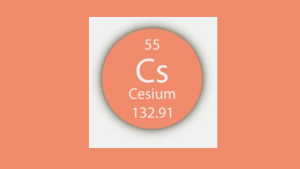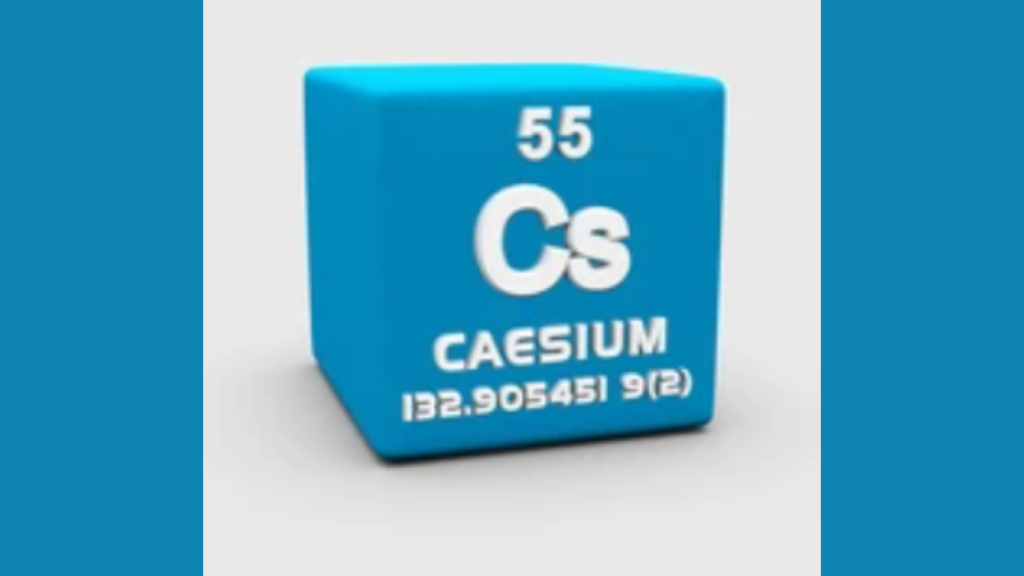The electron configuration for cesium is [Xe]6s1. Cesium has one valence electron in its outermost energy level, making it highly reactive and able to form various ionic compounds and alloys.
Cesium is an alkaline metal with the atomic number 55. It is a soft and ductile metal that can be easily cut with a knife and has a silvery-gold appearance. Cesium is highly reactive due to the presence of only one valence electron in its outermost energy level, which makes it readily give up this electron to form positive ions in solution.
Cesium’s high reactivity also results in its explosive reaction when in contact with water. Despite its reactivity, cesium has several practical applications in industry, including its use in atomic clocks, petroleum drilling, and photoelectric cells.
What Is Electron Configuration
Electron configuration refers to the number of electrons present at each energy level or orbit of an atom. It describes how electrons are distributed in various atomic orbitals or energy levels around the nucleus of an atom. The electronic structure of different elements determines their chemical properties and reactivity.
Definition Of Electron Configuration
Electron configuration is the arrangement of electrons in the atomic shell of an atom or molecule in their ground state, excited state, or any other energy state. It is represented using a series of letters and numbers that indicate the number of electrons in each shell or subshell. The energy levels are numbered from one to seven, while the orbitals are represented by the letters s, p, d, and f.
Significance Of Electron Configuration
Electron configuration is essential for understanding the behavior of atoms and molecules in chemical reactions and bonding. The arrangement of electrons in the outermost or valence shell is responsible for an element’s chemical properties and reactivity. Elements with the same number of valence electrons exhibit similar chemical properties. Therefore, electron configuration plays a vital role in predicting the reactivity of elements and their place in the periodic table.
| Orbital | Number of Electrons |
|---|---|
| 1s | 2 |
| 2s | 2 |
| 2p | 6 |
| 3s | 2 |
| 3p | 6 |
| 4s | 2 |
| 3d | 10 |
| 4p | 6 |
| 5s | 2 |
| 4d | 10 |
| 5p | 6 |
| 6s | 1 |
The electron configuration of cesium, a chemical element with an atomic number of 55, is 1s2 2s2 2p6 3s2 3p6 4s2 3d10 4p6 5s2 4d10 5p6 6s1. This means that it has one valence electron in its outermost shell and belongs to the group of alkali metals.
- Electron configuration describes the distribution of electrons in an atom.
- It is essential for understanding the chemical properties of elements.
- Elements with the same number of valence electrons exhibit similar chemical properties.
In conclusion, understanding electron configuration is essential for predicting the behavior of atoms and molecules in chemical reactions and bonding. It helps to explain the chemical properties and reactivity of elements and their place in the periodic table.
Understanding Cesium
Cesium, a highly reactive alkali metal, has an electron configuration of [Xe] 6s1. The outer energy level of its atom contains only one electron, making it easy to lose and form positive ions. Understanding its electron configuration is crucial to comprehend its chemical properties.
Introduction To Cesium
Cesium is a highly reactive and soft alkali metal that belongs to the periodic table’s group 1 elements. It’s denoted by the chemical symbol ‘Cs’ and has an atomic number of 55, comprising 55 protons and electrons. Cesium is the most active of all stable metals, and it oxidizes in the air rapidly. Due to its high atomic mass and low ionization energy, atomic physicists, medical professionals, and geophysicists rely heavily on cesium for various applications.
Atomic Structure Of Cesium
Cesium has a unique electron configuration that distinguishes it from all other stable metals. It has a single valence electron in its outermost shell, located in the s-subshell. The atomic structure of Cesium comprises six energy shells, with the first shell containing two electrons, the second and third with eight electrons, the fourth with 18 electrons, the fifth with 18 electrons, and the sixth shell containing just one electron. This lone valence electron in cesium’s outermost electronic shell is readily lost, making cesium highly reactive.
Occurrence Of Cesium In Nature
Cesium is a rare metal that is present in trace amounts in the Earth’s crust. It occurs primarily in minerals such as pollucite and lepidolite. Pollucite deposits are located in Russia, Zimbabwe, and Canada, while lepidolite deposits can be found in Brazil, Madagascar, Portugal, and the United States. Cesium is also present in the seawater. In conclusion, cesium has a unique atomic structure, and its electron configuration makes it highly reactive and useful in various fields. Though rare, scientists and researchers still find a way to extract it for various applications.
Electron Configuration Of Cesium
Cesium’s electron configuration is [Xe] 6s1. With a single electron in its outermost shell, it is highly reactive and easily forms compounds with other elements. This electron configuration is important in understanding its chemical properties.
Cesium is a soft, silvery-gold alkali metal with an atomic number of 55. Its electron configuration, or the arrangement of electrons within its atomic orbitals, can be determined by applying three fundamental principles of quantum mechanics: the Aufbau Principle, Hund’s Rule, and the Pauli Exclusion Principle.
Explanation Of Cesium Atomic Number
The atomic number of cesium corresponds to the number of protons in its nucleus. Cesium possesses 55 protons, thus its atomic number is 55. Along with being the fifth element in Group 1 of the periodic table, it has an atomic mass of 132.91 g/mol, and its electron configuration can be represented as [Xe] 6s1.
Aufbau Principle
The Aufbau principle states that electrons are added to low-energy orbitals first before higher-energy orbitals. As a result, the electron configuration for cesium starts in the first energy level, followed by the second and third energy levels. The s-subshell of the third energy level houses only one electron for the cesium atom.
Hund’s Rule
Hund’s rule states that every orbital receives one electron within a subshell before any orbital receives a second electron. For the electron configuration of cesium, its 6s-subshell is singly occupied by one electron, satisfying Hund’s rule.
Pauli Exclusion Principle
The Pauli exclusion principle states that no two electrons in an atom can have the same set of four quantum numbers. Simply put, each electron in an atom is unique, and electrons within a subshell must have opposite spins. For cesium’s electron configuration of [Xe] 6s1, the electron occupying the s-subshell must have an upward spin.
Steps To Write Electron Configuration For Cesium
The following are the steps required to write the electron configuration of cesium:
- Determine the atomic number of cesium, which is 55.
- Identify the location of cesium on the periodic table. It is the fifth element in Group 1.
- Start filling electrons with the Aufbau Principle, starting from the 1s orbital, followed by the 2s, 2p, 3s, 3p, 4s, 3d, 4p, 5s, 4d, 5p, 6s, 4f, 5d, and 6p orbitals.
- Apply Hund’s Rule and place unpaired electrons in separate orbitals within the same subshell.
- Use the Pauli Exclusion Principle to ensure that no two electrons have the same set of four quantum numbers.
- Finally, it represents the electron configuration of cesium as [Xe] 6s1.
Electronic Configuration Notation Of Cesium
1. It boasts a unique subshell configuration that satisfies the fundamental principles of quantum mechanics, including the Aufbau Principle, Hund’s Rule, and Pauli Exclusion Principle.
Applications Of Cesium
Cesium has an electron configuration of [Xe]6s¹, which makes it highly reactive and useful in many applications. It is commonly used in atomic clocks, drilling for oil and gas, as well as in photoelectric cells for energy conversion.
Cesium, a highly reactive alkali metal, has various applications in various industries. One of the fascinating properties of cesium is its electron configuration, which makes it an ideal element for high-precision atomic clocks. In this section, we will explore the applications of cesium in more detail, focusing on two essential sub-topics: Use in Atomic Clocks and Other Applications of Cesium.
Use In Atomic Clocks
Cesium’s atomic structure and precision make it an ideal component for atomic clocks, which are the most accurate timekeeping devices known to man. These clocks work by measuring the vibrations of cesium atoms, which oscillate at a specific frequency of 9,192,631,770 hertz. Using cesium in atomic clocks has revolutionized modern navigation, communication, and satellite technology.

Other Applications Of Cesium
Besides atomic clocks, cesium has several other applications in industries such as mining, oil drilling, and manufacturing. Here are some of the ways in which cesium is used in various fields:
- Cesium vapor is used as a drilling fluid in oil wells because of its high density and ability to stabilize high-pressure formations.
- Cesium is used in the production of photocells, which are used to convert light to electricity.
- The unique properties of cesium allow it to act as a catalyst in the production of certain chemicals.
- Cesium has applications in atomic vapor laser isotope separation (AVLIS), a process used to produce enriched isotopes for research and nuclear power.
In conclusion, cesium’s electron configuration and properties make it a valuable asset in several industries. Its use in atomic clocks has significantly impacted modern communication, navigation, and technology. With more research and development, we can expect to see new applications of cesium in the future. Google maps
Frequently Asked Questions On Electron Configuration For Cesium
How Do You Write The Electron Configuration For Cesium?
The electron configuration for cesium is 1s2 2s2p6 3s2p6d10 4s2p6d10f14 5s2p6d1.
What Is The Electron Configuration Of 55?
The electron configuration of 55, which is cesium, is 1s2 2s2 2p6 3s2 3p6 4s2 3d10 4p6 5s2 4d10 5p6 6s1.
What Is 1s2 2s2 2p6 3s2 3p4?
1s2 2s2 2p6 3s2 3p4 is the electron configuration of chlorine (Cl), a highly reactive green-yellowish gas. It tells us how the element’s electrons are arranged in different orbitals. The numbers in the configuration represent the number of electrons in each orbital.
What Is The Electron Configuration Of Co?
The electron configuration of CO is 1s2 2s2 2p2 3s2 3p2.
Conclusion
So there you have it—the electron configuration for cesium! Understanding the arrangement of electrons within an atom can give insight into its behavior and properties. Cesium’s configuration reveals its highly reactive nature and potential applications in fields such as atomic clocks and photoelectric cells.
By mastering the principles of electron configuration, we can unravel the mysteries of the atomic world and pave the way for new discoveries and advancements.
